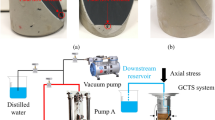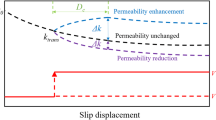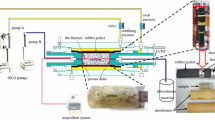Abstract
Fluid injection-triggered seismicity has increased dramatically over the last decade with elevated pore fluid pressures acting as a prime culprit. Thus, understanding the effect of pore fluid pressure on the mechanical and hydrologic behavior of fractures and faults will illuminate the contributing and dominant physical processes. We present concurrent measurements of shear displacement and flow to quantify the evolution of frictional strength, stability and permeability of schist during the full seismic cycle. We use a miniature double direct shear (mini-DDS) apparatus to conduct velocity step** (VS for stability) and slide-hold-slide (SHS for frictional healing). Our results demonstrate that increasing pore fluid pressures can stabilize frictional slip under otherwise invariant effective stresses. This implies that elevated pressures favor stable slip as a material characteristic even in the absence of decreasing critical fault stiffness (thereby increasing stability) as a result of decreased effective stress. However, the magnitude of pore pressure does not control permeability evolution during velocity steps as pore pressure does not control aperture dilation/compaction for an invariant effective normal stress. During SHS tests, it is shown that the magnitude of normalized permeability change increases with hold time and that the rate of permeability change generally decreases with the increment of pore fluid pressure, suggesting that high fluid pressures may limit permeability change during interseismic response, although creep response may still dominate over the long term.
Article Highlights
-
Increasing pore fluid pressures stabilizes frictional slip under invariant effective stresses.
-
The magnitude of pore pressure is not a dominant control on permeability evolution for an invariant effective normal stress.
-
Elevated pore fluid pressure reduces healing rate and limits permeability change rate for invariant effective normal stresses.




Similar content being viewed by others
References
Andrews DJ (2002) A fault constitutive relation accounting for thermal pressurization of pore fluid. J Geophys Res: Solid Earth 107(B12):ESE-15
Bao X, Eaton DW (2016) Fault activation by hydraulic fracturing in western Canada. Science 354(6318):1406–1409
Brace WF, Martin RJ (1968) A test of the law of effective stress for crystalline rocks of low porosity. Int J Rock Mech Mining Sci Geomech Abstr 5(5):415–426
Byerlee JD (1968) Brittle-ductile transition in rocks. J Geophys Res 73(14):4741–4750
Candela T et al (2015) Flow rate dictates permeability enhancement during fluid pressure oscillations in laboratory experiments. J Geophys Res: Solid Earth 120(4):2037–2055
Carpenter BM, Matt JI, Marone C (2016) Laboratory observations of time-dependent frictional strengthening and stress relaxation in natural and synthetic fault gouges. J Geophys Res: Solid Earth 121(2):1183–1201
Deichmann N, Giardini D (2009) Earthquakes induced by the stimulation of an enhanced geothermal system below Basel (Switzerland). Seismol Res Lett 80(5):784–798
den Hartog SA, Spiers CJ (2013) Influence of subduction zone conditions and gouge composition on frictional slip stability of megathrust faults. Tectonophysics 600:75–90
Deng K, Liu Y, Harrington RM (2016) Poroelastic stress triggering of the December 2013 Crooked Lake, Alberta, induced seismicity sequence. Geophys Res Lett 43(16):8482–8491
Dieterich JH (1979) Modeling of rock friction: 1. Experimental results and constitutive equations. J Geophys Res: Solid Earth 84(B5):2161–2168
Dieterich JH (1981) Constitutive properties of faults with simulated gouge. Mech Behav Crustal Rocks 24:103–120
Dieterich JH, Kilgore BD (1996) Imaging surface contacts: power law contact distributions and contact stresses in quartz, calcite, glass and acrylic plastic. Tectonophysics 256(1–4):219–239
Fang Y, Wang C, Elsworth D, Ishibashi T (2016) Friction-permeability relationships for reservoir caprocks. Paper presented at the 50th U.S. Rock Mechanics/Geomechanics Symposium, Houston, Texas
Fang Y et al (2017) Frictional stability-permeability relationships for fractures in shales. J Geophys Res: Solid Earth 122(3):1760–1776
Fang Y et al (2018) Permeability evolution and frictional stability of fabricated fractures with specified roughness. J Geophys Res: Solid Earth 123(11):9355–9375
Faoro I et al (2009) Influence of shear and deviatoric stress on the evolution of permeability in fractured rock. J Geophys Res: Solid Earth. https://doi.org/10.1029/2007JB005372
French ME, Zhu W (2017) Slow fault propagation in serpentinite under conditions of high pore fluid pressure. Earth Planet Sci Lett 473:131–140
Frohlich C, Brunt M (2013) Two-year survey of earthquakes and injection/production wells in the Eagle Ford Shale, Texas, prior to the Mw4. 8 20 October 2011 earthquake. Earth Planet Sci Lett 379:56–63
Hubbert MK, Rubey WW (1959) Role of fluid pressure in mechanics of overthrust faulting: I. Mechanics of fluid-filled porous solids and its application to overthrust faulting. GSA Bull 70(2):115–166
Im K, Elsworth D, Fang Yi (2018) The influence of preslip sealing on the permeability evolution of fractures and faults. Geophys Res Lett 45(1):166–175
Im K, Elsworth D, Wang C (2019) Cyclic permeability evolution during repose then reactivation of fractures and faults. J Geophys Res: Solid Earth 124(5):4492–4506
Ishibashi T et al (2016) Linking microearthquakes to fracture permeability change: the role of surface roughness. Geophys Res Lett 43(14):7486–7493
Ishibashi T et al (2018) Friction-stability-permeability evolution of a fracture in granite. Water Resour Res 54(12):9901–9918
Li Z et al (2019) A new apparatus for the concurrent measurement of friction and permeability evolution in fault gouge. Int J Rock Mech Mining Sci 121:104046
Marone C (1998a) Laboratory-derived friction laws and their application to seismic faulting. Annu Rev Earth Planet Sci 26(1):643–696
Marone C (1998b) The effect of loading rate on static friction and the rate of fault healing during the earthquake cycle. Nature 391(6662):69–72
Martin III, Randolph J (1980) Pore pressure stabilization of failure in Westerly granite. Geophys Res Lett 7(5):404–406
Ougier-Simonin A, Zhu W (2015) Effect of pore pressure buildup on slowness of rupture propagation. J Geophys Res: Solid Earth 120(12):7966–7985
Rice JR (1975) On the stability of dilatant hardening for saturated rock masses. J Geophys Res 80(11):1531–1536
Rudnicki JW, Chen C-H (1988) Stabilization of rapid frictional slip on a weakening fault by dilatant hardening. J Geophys Res: Solid Earth 93(B5):4745–4757
Samuelson J, Elsworth D, Marone C (2009) Shear-induced dilatancy of fluid-saturated faults: experiment and theory. J Geophys Res: Solid Earth. https://doi.org/10.1029/2008JB006273
Sawai M et al (2016) Nucleation of frictional instability caused by fluid pressurization in subducted blueschist. Geophys Res Lett 43(6):2543–2551
Scuderi MM, Collettini C, Marone C (2017) Frictional stability and earthquake triggering during fluid pressure stimulation of an experimental fault. Earth Planet Sci Lett 477:84–96
Sibson RH (1973) Interactions between temperature and pore-fluid pressure during earthquake faulting and a mechanism for partial or total stress relief. Nat Phys Sci 243(126):66–68
Wang W, Scholz CH (1994) Wear processes during frictional sliding of rock: a theoretical and experimental study. J Geophys Res: Solid Earth 99(B4):6789–6799
White M et al (2018) A suite of benchmark and challenge problems for enhanced geothermal systems. Geomech Geophys Geo-Energy Geo-Resour 4(1):79–117
Witherspoon PA et al (1980) Validity of cubic law for fluid flow in a deformable rock fracture. Water Resour Res 16(6):1016–1024
**ng T et al (2019) Stabilizing effect of high pore fluid pressure on slip behaviors of gouge-bearing faults. J Geophys Res: Solid Earth 124(9):9526–9545
Yasuhara H, Marone C, Elsworth D (2005) Fault zone restrengthening and frictional healing: the role of pressure solution. J Geophys Res: Solid Earth. https://doi.org/10.1029/2004JB003327
Ye Z, Vachaparampil A, Zhou X, Ghassemi A, Kneafsey T (2019) February. Failure behavior of the Poorman schist and its fractures from EGS collab stimulation site. In 44th workshop on geothermal reservoir engineering
Yoon CE et al (2017) Seismicity during the initial stages of the Guy-Greenbrier, Arkansas, earthquake sequence. J Geophys Res: Solid Earth 122(11):9253–9274
Zhang S, Tullis TE, Scruggs VJ (1999) Permeability anisotropy and pressure dependency of permeability in experimentally sheared gouge materials. J Struct Geol 21(7):795–806
Acknowledgements
This work is a partial result of support from the DOE EGS Collab Project: Stimulation Investigations for Geothermal Modeling, Analysis and Validation and from DOE award DE-EE0008763. This support is gratefully acknowledged. EGS-Collab Team—Author list appended at the end of the manuscript.
EGS-Collab Team members by organization
DOE: L. Boyd, Z. Frone, E. Metcalfe, A. Nieto, S. Porse, W. Vandermeer. INL. R. Podgorney, G. Neupane. LBNL: J. Ajo-Franklin, P.J. Cook, P.F. Dobson, C.A. Doughty, Y. Guglielmi, M. Hu, R.S. Jayne, K. Kim, T. Kneafsey, S. Nakagawa, G. Newman, P. Petrov, M. Robertson, J. Rutqvist, M. Schoenball, E.L. Sonnenthal, F.A. Soom, C. Ulrich, C.A. Valladao, T. Wood, Y.Q. Zhang, Q. Zhou. LANL: L. Huang, Y. Chen, B. Chi, Z. Feng, L.P. Frash, K. Gao, E. Jafarov, S. Karra, N. Makedonska, W. Pan, R. Pawar, N. Welch. LLNL: P. Fu, R.J. Mellors, J.P. Morris, M.M. Smith, D. Templeton, H. Wu. NETL: J. Moore, S. Brown, D. Crandall, P. Mackey, T. Paronish, S. Workman. NREL: B. Johnston, K. Beckers, J. Weers. ORNL: Y. Polsky, Monica Maceira, Cheng** Chai. PNNL: A. Bonneville, J.A. Burghardt, J. Horner, T.C. Johnson, H. Knox, J. Knox, B.Q. Roberts, P. Sprinkle, C.E. Strickland, J.N. Thomle, V.R. Vermeul, M.D. White. SNL: D. Blankenship, M. Ingraham, J. Pope, P. Schwering, A. Foris, DK King, J. Feldman, M. Lee, J. Su. SURF: T. Baumgartner, J. Heise, M. Horn, B. Pietzyk, D. Rynders, G. Vandine, D. Vardiman, Subs: Thomas Doe, TDoeGeo Rock Fracture Consulting; Golder Associates Inc; J. McLennan, University of Utah. CSM – Y.S. Wu, J. Miskimins, P. Winterfeld, K. Kutun. Stanford—M.D. Zoback—A. Singh, Stanford—R.N. Horne, K. Li, A. Hawkins, Y. Zhang. Mattson Hydrology LLC: E. Mattson. Penn State—D. Elsworth, K.J. Im, Z. Li, C.J. Marone, E.C. Yildirim. Rice University—Jonathan Ajo-Franklin. The University of Oklahoma—A. Ghassemi, Dharmendra Kumar, Varahanaresh Sesetty, Alex Vachaparampil. University of Wisconsin -Madison– H.F. Wang, Hiroki Sone, Kate Condon, and Bezalel Haimson. South Dakota School of Mines and Technology—W. Roggenthen, C. Medler, N. Uzunlar, Carson Reimers. ResFrac—M.W. McClure
Author information
Authors and Affiliations
Corresponding authors
Ethics declarations
Conflict of interest
On behalf of all authors, the corresponding author states that there is no conflict of interest.
Additional information
Publisher's Note
Springer Nature remains neutral with regard to jurisdictional claims in published maps and institutional affiliations.
Rights and permissions
Springer Nature or its licensor (e.g. a society or other partner) holds exclusive rights to this article under a publishing agreement with the author(s) or other rightsholder(s); author self-archiving of the accepted manuscript version of this article is solely governed by the terms of such publishing agreement and applicable law.
About this article
Cite this article
Li, Z., Elsworth, D. & Wang, C. Effect of pore pressure magnitude on the frictional properties and permeability evolution of fractures in schist. Geomech. Geophys. Geo-energ. Geo-resour. 8, 214 (2022). https://doi.org/10.1007/s40948-022-00504-0
Received:
Accepted:
Published:
DOI: https://doi.org/10.1007/s40948-022-00504-0




